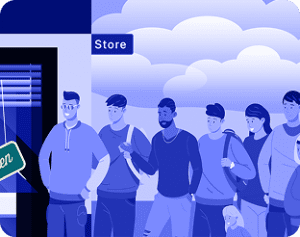Predictive Customer Analytics is a data-driven approach that leverages historical data and machine learning techniques to forecast future customer behavior. What separates this from traditional business intelligence is that it not only analyzes past trends but goes a step further by actively predicting future outcomes.
In essence, predictive analytics empowers businesses to move beyond reactive responses and embrace a proactive, customer-centric approach.
The Nuts and Bolts of Predictive Customer Analytics
Let’s explore how predictive customer analytics works. It follows a systematic approach involving multiple key steps:
1. Data Collection
Predictive models depend on a robust foundation of data from various sources. This includes CRM, POS, website analytics, social media, user feedback, and other discrete sources.
2. Data Cleaning
The collected data often requires significant preprocessing. Data engineers clean it by identifying and correcting inconsistencies and removing duplicates. They convert it to suitable formats for analysis and create new variables from existing data to improve model accuracy.
3. Model Training
Data scientists employ various statistical and machine learning algorithms, including:
- Regression analysis: Predicting continuous outcomes (e.g., CLTV).
- Classification algorithms: Predicting categorical outcomes (e.g., churn or fraud).
- Clustering algorithms: Grouping customers into segments.
- Time series analysis: Forecasting future trends based on historical data.
4. Evaluation and Validation
The trained model is rigorously tested to assess its reliability. Common evaluation metrics include accuracy, recall, precision, and F1 score. Techniques like cross-validation are used to ensure the model’s ability to generalize well to new, unseen data. This helps prevent overfitting, where the model performs well on the training data but poorly on real-world data.
5. Deployment
Once validated, the model is deployed into a production environment to make real-time predictions. The model is monitored and regularly retrained with updated data for peak performance.
Benefits of Predictive Analytics in Customer Experience
Predictive customer analytics empowers businesses to make smarter decisions based on pure data instead of gut feelings. Currently, over 40% of organizations are leveraging data analytics for decision-making and reaping the benefits. Let’s explore some real-world use cases of how you can use predictive analytics to drive growth.
- Personalized Customer Journeys: You can create highly personalized customer journeys by analyzing customer data to understand individual customer preferences and behaviors.
- Enhanced Customer Retention: Predictive customer analytics can effectively identify customers at high risk of churn.
- Improved Customer Service: You can anticipate customer needs and proactively address potential issues using tools like chatbots powered by PCA.
- Better Customer Engagement: Predictive analytics helps increase customer engagement by personalizing your messaging.
- Enhanced Customer Loyalty: Predictive analytics helps you provide exceptional customer service, which in turn helps increase customer lifetime value.
Where to Collect Data for Predictive Analytics Software?
Data is the food for AI-driven predictive analytics tools. High-quality data is the foundation of success. Here are the key platforms where you can effectively gather the data you need:
- CRM Systems: Customer demographics, contact information, purchase history, communication records, support tickets, and survey responses.
- POS Systems: Transactional data (date, time, products purchased, quantities, prices), customer loyalty information, and payment methods.
- Website Analytics: Website traffic, user behavior (page views, time spent on site, bounce rate), conversion rates, product views, search queries.
- Social Media: Customer interactions (likes, comments, shares), sentiment analysis, social media demographics, and influencer marketing data.
- Surveys and Feedback: Customer satisfaction scores, feedback on products/services, preferences, pain points, and suggestions.
- External Data Sources: Market research data, economic indicators, competitor information, and industry trends.
Top 15 Use Cases of Predictive Customer Analytics
- Churn Prediction: Predicts customer churn based on behaviors like canceling subscriptions or brand switching.
- CLV Prediction: Identifies customers with the highest potential lifetime value for resource optimization.
- Customer Segmentation: Groups customers with similar characteristics and behaviors for targeted marketing campaigns.
- Hyperpersonalization: Recommends the most relevant products/services based on predictions of customer needs.
- Fraud Detection: Monitors websites and applications in real time to detect fraud and send alerts.
- Demand Forecasting: Forecasts demand for products in different regions and time periods to optimize inventory.
- Dynamic Pricing: Predicts price elasticity of demand and adjusts pricing based on demand and competition.
- Marketing Campaign Optimization: Forecasts ROI of marketing campaigns to allocate budgets to the most promising channels.
- Personalized Pricing: Recommends the right price and time for conversions with discounts, promotions, and loyalty programs.
- Customer Service Automation: Identifies and addresses customer issues proactively with AI-driven solutions.
- Sales Forecasting: Forecasts sales trends and aids in strategizing for better planning.
- Risk Management: Identifies potential risks (financial, compliance, market disruptions, cybersecurity) for effective mitigation.
- Personalized Customer Support: AI tools predict customer inquiries and offer solutions accordingly to enhance the customer experience.
- Next Best Action: Predicts the next best action for each customer based on behaviors and preferences.
- Product Recommendations: Recommends products based on past purchasing behavior to increase upsell and cross-sell opportunities.
Conclusion
As businesses navigate today’s unpredictable market, predictive customer analytics provides an indispensable advantage. The power to foresee customer behavior and act proactively can transform your business’s fortunes. Leverage predictive analytics to gain a competitive edge, drive customer loyalty, and ultimately, enhance your bottom line.





